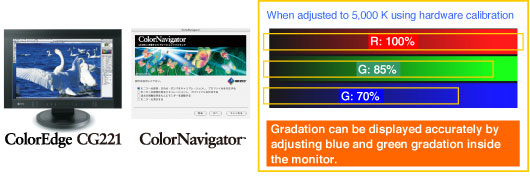Color Management Resources
Monitor Calibration
- Security
- ATC Resources
- Monitor Basics in Plain English
- Videos
- Color Management Resources
- The Breath of Living Creatures - takayuki-maekawa
- Visit to the EIZO Headquarters – ColorEdge Factory Tour
- Exhibit of Virtual Human Saya - ColorEdge as an Eye to the Artist
- A Professional Photographer’s Visit to the EIZO Factory
- How to Read the ColorEdge Factory Report
- The Winners of the Academy Sci-Tech Award – ColorEdge CG Series Developer Interview
- Color Management for Creators – A Comprehensive Guide
- Color Management for Creators – Mobile Devices
- Award-Winning Calibration Sensor Technology
- Hardware vs Software Calibration
- EIZO Colourclass
- Color Management for Creators – Web Browser Edition
- Color Management for Creators – ICC Profiles
- Adorable Kitties on an EIZO ColorEdge: A Professional Monitor Great for Everyone
- Choosing the Color Gamut - Adobe RGB or sRGB?
- Age of HDR
- The Ins and Outs of HDR
- Color Management for 3DCG
- EIZO ColorEdge Ambassador Q&A: 5 Tips for Hobbyist Photography
- Quick Color Match and ColorNavigator
- Certifications for the Graphics Market
- One Lesson I Iearned in Photography
- How to Color Match Your ColorEdge Monitor and Photo Prints
- Color Management in Practice
- Choosing the Right Monitors for a Color Management System
- Monitor Calibration
- Healthcare Resources
Hardware calibration
Advantages
Hardware calibration enables easy calibration in a short period of time, using specialized hardware and software.
In addition, since hardware calibration controls the hardware of the monitor directly, this method offers high precision and good gradation characteristics.
As with the example for software calibration on the previous page, hardware calibration will be described here using the example of adjustment to 5,000 K.
When reducing green output to 85% and blue to 70% inside the monitor, hardware calibration differs from software calibration in that the number of gradations (reduced in software calibration) is adjusted to 256 with the hardware-based method. This adjustment allows for accurate gradation display, with no loss in the number of available gradations. In addition, since the calibration process is fully automatic, precision remains high even after repeated calibration. As a result, hardware calibration does not involve the minor variations with each adjustment that occur in software calibration, enabling the preparation of more accurate monitor profiles.
Drawbacks
Since calibration monitors are specially designed, they cost more than ordinary monitors. In addition, some monitors on the market that are compatible with hardware calibration have drawbacks: offering insufficient precision, for example, or requiring a very long time for calibration, even when fully automatic.
